Part 3 In Harlan’s “Thinking Expansion?” Series
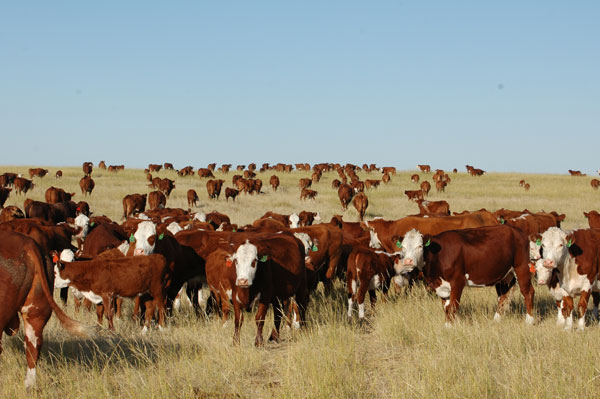
Today’s record beef prices certainly suggest expansion. In fact, my current budgets for eastern Wyoming and western Nebraska project a profit of more than $580/cow for the production of 2014 fall-weaned calves!
This year’s rapid price increases require each rancher to rethink his long-run business plan. Such profit opportunity comes around only one or twice in a rancher’s lifetime, and how one responds is critical to the long-run economic performance of the beef cowherd.
For those nearing retirement, the current prices offer the opportunity for a very profitable and slow exit from the ranching business. But a retiring rancher will want to spread the sale over three or more years for income tax purposes. Cattle prices should remain high for the next few years.
I suggest selling all calves born each year, slowly decreasing herd numbers. With no replacements retained and intensive cow culling while cattle prices are up, a herd will decrease 15%-25% annually. After three years, the rancher can then decide whether to liquidate the remainder of the herd or continue to shrink the herd for a few more years. This strategy will allow retiring ranchers to convert their cowherd into a nice retirement nest egg.
Meanwhile, other ranchers have five options:
Continue with a static herd, holding back just enough replacement heifers to maintain herd numbers. This should provide above-average returns for the next several years.
Grow your steer calves to heavy feeders for the next few years, and maintain steady cowherd numbers. Feedlots will remain short of feeder cattle during the early years of the expansion, and I currently project $129 in additional profit for 2014 steers grown out to and marketed at 800 lbs. Growing to heavier weights should add even more profit. Budget through the growing out of your steer calves each year before executing your plan, as the economics will change as the national herd expands.
Expand the herd slowly during the good price years. High calf prices will lead to good cash flow from the herd, even if you’re selling a few less heifer calves. This was a popular strategy in past cattle cycles.
Expand your herd substantially by holding back additional replacement heifers — perhaps even doubling the number retained. Be sure yours is a high-profit herd going into this option, as cash flow can drop in the early years of a major expansion.
Sell every calf born when calf prices and demand are high, and bank the extra money earned. Later, when calf prices and demand for calves are low, retain as many heifers as possible and rebuild the herd. In other words, when everyone else is buying, you sell; when everyone else is selling, you hold and expand. While the economics of this strategy can be very favorable, it also can stress production resources — especially of grass — during your expansion years.
The key to evaluating your best business plan is to first develop a set of planning prices for the next few years. I’ll devote the rest of this column to my current price analysis and short-term price projections for marketing 2014 calves.
Let’s study the mid-June 2014 sale-barn prices for western Nebraska (Figure 1). Note that the price variation around the trend line in Figure 1 tends to reflect the quality of the steers sold. While sale-barn numbers are low, prices are not. All steers less than 800 lbs. brought more than $200/cwt.
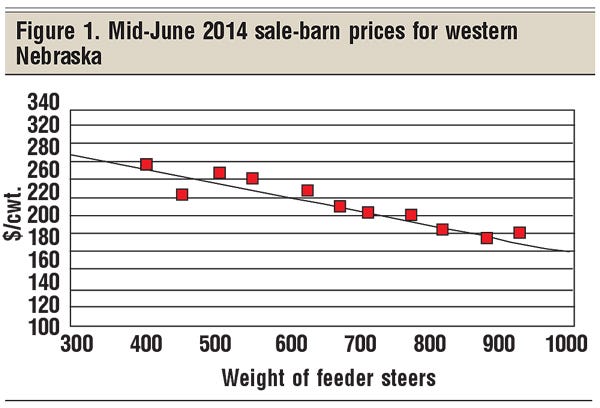
Figure 2 compares sale-barn prices with one month and one year before. The red line in Figure 2 depicts the statistical price line for mid-June 2014 sale-barn prices, which are record-high. The blue line depicts sale-barn prices for mid-May 2014, and the yellow line represents sale-barn prices for June 2013.
Having a statistical price line (red line, Figure 2) allows one to further dissect current prices as summarized in Figure 3. The first two columns list the weight of steer calves in 25-lb. increments and the statistical sale-barn market prices by cwt. Notice that 550-lb. steer calves averaged $247/cwt., while 850-lb. feeder steers averaged $200.29/cwt. in mid-June 2014.
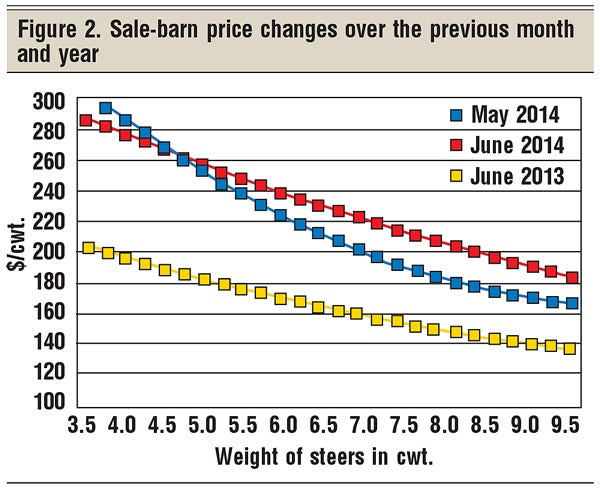
The price-drop column is the calculated price slide for each individual weight. True price slides tend to vary with the weight of steer calves marketed. The price slide for 550-lb. steers was a minus $17.76, while the price slide for 850-lb. steer calves was a minus $13.78.
The value/head column is just price times weight. Calves weighing 550 lbs. averaged $1,362/head, while 850-lb. feeder steers averaged $1,703/head. These prices are why one might consider selling every calf born during these record-price times.
The implication of price slides is that we know that the value of the last pound changes as the weight of the steer calf changes. The economics of added weight on a steer calf must be evaluated via the “value of the last lb.” and not average calf price, as is frequently done. Value of the last lb. is always under the average calf price.
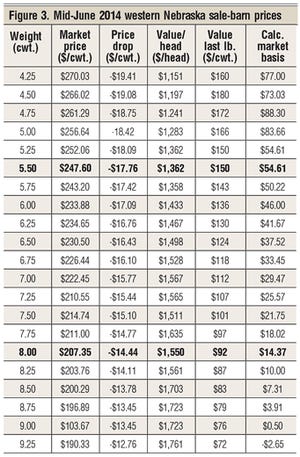 Finally, the last column reflects the market price basis (cash price minus futures) for these midmonth prices. Basis is currently extremely high, which reflects the extremely strong market.
Finally, the last column reflects the market price basis (cash price minus futures) for these midmonth prices. Basis is currently extremely high, which reflects the extremely strong market.
I use feeder-cattle futures prices to generate a set of price projection tables like Figure 3 for five key marketing periods in a year. These tables are summarized in Figure 4, which presents actual market prices for 2012 and 2013; and January, March and spring 2014. Price projections are presented for September and fall-2014 weaning time. I currently project fall-2014 weaned steer calves in the $260/cwt. range. If this price materializes, I project a $580/beef cow profit in my demonstration eastern Wyoming/western Nebraska beef cowherd!
The bottom two lines in Figure 4 present the mid-June 2014 live-cattle futures prices for these same key marketing months. The current futures market is suggesting slaughter-cattle prices near $150/cwt. by the end of 2014.

My analysis also suggests that growing out 2014 calves to 850 lbs. or more should be profitable, perhaps even more than expanding a herd with 2014’s expensive replacement heifers. Stay tuned.
The economics of grass cattle
Utilizing the planning prices highlighted for 2014 in Figure 4, let’s look at the economics of running grass cattle in summer 2014.
The left-hand side of Figure 5 presents the cost side of running grass steers in eastern Wyoming or western Nebraska. The key here is that this year’s actual spring price and my projected fall selling price for 800-lb. feeders generates a record low buy/sell margin – a negative $2. (Note what the buy/sell margins were for 2012 and 2013.)
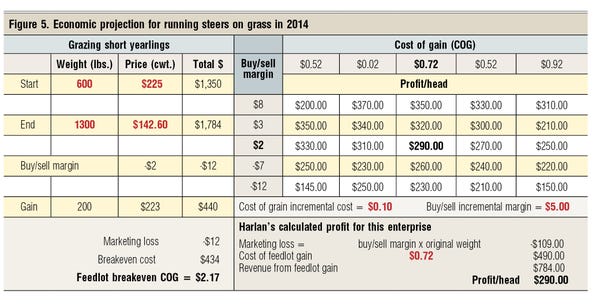
This, then, suggests a marketing cost of a minus $12 – the lowest in years. Selling the added weight for $2.23/lb. with a cost of gain projected at 72¢/lb. generates a $290/steer projected profit. I doubt that ranchers will be able to duplicate this in 2015.
In summary, my analysis suggests that growing out your 2014 calves to 800-850 lbs. should prove profitable. This could well be more profitable than expanding your herd with 2014 expensive replacement heifers. Stay tuned.
Tough climate conditions
Mother Nature is not cooperating real well this summer on a national basis. A study of the current Drought Monitor suggests that Kansas, Oklahoma and West Texas are suffering from drought. In addition, several western states, including California and Oregon, are also suffering. California has the most serious drought and is reducing its beef cowherd. These states are unlikely to expand this year.
The Mountain, Northern Plains, Corn Belt and Southeast states have had more normal rainfall. I expect these states are already expanding their cowherds. Meanwhile, national cow slaughter in 2014 is down, so the industry is primed to expand in those areas with summer forage.
Harlan Hughes is a North Dakota State University professor emeritus. He lives in Kuna, ID. Reach him at 701-238-9607 or [email protected].
More articles to enjoy:
8 Tips For Stress-Free Cattle Handling
5 Trending Headlines: Mobile Shade For Cattle & Animal Ag Wins An Antibiotic Lawsuit
Parasite & Pest Management Products To Consider
New Stocker Index Prices Stocker Calves More Precisely
7 U.S. Ranching Operations Are "Best of the Best" In Stewardship
Enjoy A Laugh On Us! 20 Dick Stubler Ranch Life Cartoons
About the Author(s)
You May Also Like




.png?width=300&auto=webp&quality=80&disable=upscale)
